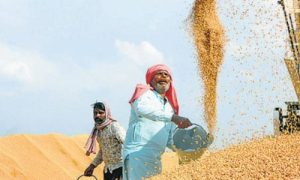Cereals under climate threat

Rising temperatures threaten wheat yields globally, prompting concerns about India’s production stability despite government estimates. Procurement data suggests a discrepancy, with Madhya Pradesh notably experiencing low wheat acquisition. Amid lower stocks and increased rice substitution in public distribution, questions linger on wheat sufficiency for PDS and market interventions amidst rising prices and climate impacts on crops.
By Renu Kohli
Temperature above a threshold impacts the yield of any food grain crop due to excessive evapotranspiration, especially wheat, a winter crop. However, this varies across different stages of growth and corresponding degree of temperature variations. Rising incidents of heatwaves are alarming scientists, while countries face declining wheat yields and output. Could India have been an exception? The wheat production estimates suggest there’s not much to worry, except in 2021-22 when a severe heatwave hit north India, damaging yield by ~4-5%.
However, the government’s crop estimates are not convincing, often much above market assessments. If procurement is used as a rough proxy, the estimates appear optimistic. For example, in the current rabi marketing season (March-June), the Food Corporation of India (FCI) aimed to procure ~ 37.3 million tonnes (mt) after early estimate of a record 112.9 mt output. But procurement was only 26.5 mt by June 16. Indeed, the procurement-production ratio dropped sharply to an average 22% in last three years, ~10 percentage points lower than the 32% average in FY13-FY21(table 1).
This issue is particularly glaring in Madhya Pradesh, the most recent and largest addition to wheat crop area and output. It has seen very poor procurement — a proxy for lower output — over the last three years: against record 12.9 mt and 12.8 mt in FY20-FY21, procurement plunged to 4.6, 7.1, and 4.8 mt in FY22-FY24 respectively (table 2). From a 70% peak in FY21, the procurement/production ratio fell to 20% and 30% in FY22 and FY23, much beyond comprehension.
It could be argued that private traders directly bought larger-than-usual amounts from farmers. But this appears unrealistic as overall output declined by just 1.9 mt in FY22 over FY21, whereas procurement declined 24.5 mt! That’s an extremely large quantity for traders to finance and have warehouse space to stock, given there was no big leap in wheat export. Further, while production increased by 2.9 mt in FY23, procurement was still 17.2 mt lower over FY21. More intriguing is the open market sales of ~8.9 mt that the FCI was compelled to carry out to expand private supply and quell rising prices. Therefore, lower procurement and rising prices are good proxies to infer that official crop estimates were optimistic, though it’s hard to say to what extent.
The question is if wheat crop damage from extreme temperature has become endemic and the conventional crop-cutting method for yield and output estimation is failing to capture full impact. More importantly, food supply management is pressured because of failure to replenish the additional 38.1 mt of wheat distributed by the government for three pandemic years. As of April 1, wheat stock was a bare minimum of the prescribed prudential buffer stock (7.5 mt).
Will the newly procured 26.5 mt suffice for PDS needs, leaving enough for market interventions in case price pressures persist? Looking back at FY23-FY24, it would appear so. But a deeper dig reveals the real picture. In response to lower wheat stock, the government been substituting it with rice and coarse cereals in the targeted public distribution system (TPDS) — the average wheat off-take of 16 mt was nearly 5.7 mt lower than 21.6 mt averaged over FY15-FY22, and before stocks depleted.
Clearly, the government has been cutting wheat supply through TPDS, resulting in some demand spilling to the private market, pressuring prices (table 3). On the other hand, rice off-take under TPDS rose to an average 33.2 mt in the last two years, 5.7 mt higher than the pre-Covid average (27.5 mt) since 2014-15 (table 2). This rice-for-wheat substitution policy was executed by restricting rice exports. However, this could not avert the rise in domestic rice price as well.
I had earlier flagged how persistent drought conditions alongside uncertain precipitation in recent years — possibly triggered by climate change — impacted the rice crop (https://rb.gy/s9obzi). Two consecutive years of deficient rain, rare in the rice-growing Gangetic plains, could be early warning that a rice-for-wheat substitution policy may not be sustainable. This also risks losing an international market where India is the second largest supplier.
Policy options
It’s clear that persistent extreme temperature events and uncertain precipitation could hurt India’s cereal self-sufficiency, undermining its Green Revolution successes. While some experts think the current heatwave phase triggered by El Niño will soon weaken, creating more favourable La Niña conditions, the latest Intergovernmental Panel on Climate Change report (2023) underlines that compounded heatwaves and droughts are projected to become more frequent. India must, therefore, prepare for such eventualities.
A more enduring response could be to implement suitable adaptation strategies in wheat-growing states. Several agriculture research institutes are studying the regional spread and frequency of heatwaves; hopefully, appropriate crop-breeding and management solutions may emerge. The scientific community widely acknowledges that wheat output fell across Punjab, Haryana, and MP with extreme heatwaves in March 2021-22. There’s no clarity though why procurement fell subsequently in MP in FY23-FY24 despite enhanced cultivation area, above-97% assured irrigation, and without reported crop damages from extreme hailstorms. This raises the question if the state is more vulnerable to milder heatwaves than Punjab and Haryana.
If so, there’s another critical question about the government’s food management policy. The conscious policy agenda has been to encourage Punjab and Haryana farmers to switch to cash crops, given the lower water table contributing to salinity and deteriorating soil fertility. The strength of this critical move was based on significant output increases in MP in recent years, assuring self-sufficiency. Should the supply shock from MP persist, the government must consider slowing the crop-switch in Punjab and Haryana until appropriate technological solutions against recurrent heatwaves are found. This call must be taken by scientists, given expert beliefs the groundwater conditions are acute and irreversible. A focus on raising yields in Uttar Pradesh can be considered too. Alternatively, wheat import can be considered, but there would be a broader global fallout on prices hurting poorer nations.
Source Link: https://www.financialexpress.com/opinion/cereals-under-climate-threat/3529383/

















